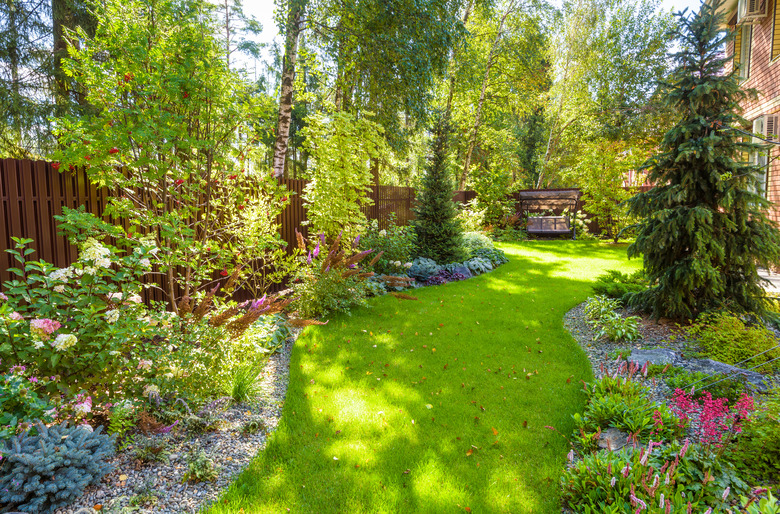How To Identify And Control Lawn Grubs
We may receive a commission on purchases made from links.
A beautiful lawn takes a bit of effort, and it's frustrating to see all your hard work undone by lawn grubs — worm-like creatures that are actually immature June beetles. Fortunately, there are several grub control methods that will get rid of any grubs you currently have, and there are pre-emptive treatments to keep them from coming back. It's also of note that you don't have to panic if you find a grub in your lawn or garden. A healthy lawn can tolerate up to five grubs per square foot without issues.
Why Grub Control Matters
How to Identify and Control Lawn Grubs
Why Grub Control Matters
Although it's nice to take a live-and-let-live approach to outdoor insects, grubs are extremely destructive little beasts that you'll want to eliminate. Early in the summer, adult beetles emerge from deep in the soil and then lay eggs. These eggs hatch into insect larvae, which are also known as grubs.
These grubs live in the ground, feasting on the roots of your grass. They typically hatch and begin feeding late in the summer and into early fall. When there are only a few of them, your lawn can withstand the damage. In an outright infestation, however, grubs can destroy the roots of your grass and kill it, leaving unsightly spots in your lawn.
How to Identify and Control Lawn Grubs
1. Confirm That It's Grubs With Which You're Dealing
The most obvious sign of grub damage is the appearance of irregularly shaped brown spots in your lawn. There are, however, a few lawn diseases that can also cause brown spots. To make sure you're truly dealing with grubs, use a spade to lift a piece of turf about the size of a Frisbee in the affected areas. You'll want to dig about 2 inches deep and then examine the soil. If you see white worms that are about 1 to 1 1/2 inches long, congratulations — you have grubs.
Other signs that you have grubs include areas of the lawn that feel spongy beneath your feet or browning turf patches that aren't dead yet but are on their way. You may also notice a lot more beetles flitting around your yard, indicating that you already have grubs or that you will next spring when the beetles lay their eggs. You may see an uptake in critters as well. Raccoons, skunks, moles and birds all enjoy eating grubs and will dig up your yard to get to them.
2. Mow the Lawn
Unfortunately, some of the products used to kill grubs and prevent them can negatively affect bees and other important pollinators. When these insects come to your yard, they're there to visit clover or dandelion flowers rather than the grass. Mowing chops down these flowers so that bees aren't attracted to your yard and don't come into contact with insecticides there.
3. Apply a Grub Control Treatment
If you do have grubs, you'll want to visit your local garden center or hardware store and purchase a grub control product. You're likely to find several choices, but the best option will be a product that contains the chemical trichlorfon. Other chemicals work well to kill insect eggs but fail to adequately attack larvae once they've hatched.
Some grub control products come in granular form, while others are available as a spray. If you are using a granular insecticide, spread the product over your lawn using a spreader at the rate directed on the product package.
After you've treated the lawn, water it with at least 1/2 inch of water. This will help move the insecticide down into the soil where it will reach the grubs. It also helps move it off the surface of your lawn so you need not worry about your children or pets being exposed to it while playing outside.
If you're using a spray, attach the bottle to your hose nozzle and apply the product as directed. You won't need to water your lawn after treatment since you'll water the insecticide into the lawn as you spray. Remember that insecticides are potentially dangerous chemicals when used improperly, and it's illegal to use them in a different manner than directed.
Whether you use a spray or granular treatment, grub-killing products will kill young grubs within 24 hours. You can then focus on reseeding, fertilizing and repairing your lawn. How long lawn repair takes depends on the extent of the damage, but you will see improvement in your lawn in about two to three weeks.
4. Repair the Damage
If you catch the lawn grubs early and treat them before they get too far, your lawn may recover on its own. Dead grass won't come back, however, so you'll have to replace it and repair the damage. Sprinkle grass seed over any bare or dead patches in your lawn.
Place a thin layer of straw over the grass seed and water it. Keep the area moist but not soggy until your grass sprouts. You can rake up the straw and start mowing your grass when the new grass blades are 2 1/2 to 3 inches tall.
5. Prepare for Next Year's Lawn Grubs
Even if you treated for grubs, some may have escaped you by burrowing more deeply into the soil. You could also face a new crop of grubs if beetles come back. To prevent more lawn grubs, treat your lawn with a grub control product in June or July. However, don't apply grub control before June. If you do, the insecticide could degrade before the beetles lay their eggs and could prove useless.
Preventive treatments work by attacking grubs very early in their life cycle, which requires different chemicals than killing older grubs. When shopping for a preventive grub control product, look for the active ingredients imidacloprid, thiamethoxam, clothianidin or chlorantraniloprole.
You'll spread the insecticide using a spreader or by spraying the lawn at the rate detailed on the product packaging. If you are using a granular product, remember to apply 1/2 inch of water to the lawn after spreading it.
6. Practice Good Lawn Care Habits
A healthy yard has a much better chance of recovering from a lawn grub issue than an unhealthy one. Keep your lawn mowed to a height of about 4 inches and fertilize it regularly to promote strong, healthy roots.
Make sure your lawn gets 1 to 1 1/2 inches of water per week during the summer growing season as well. A healthy lawn won't necessarily prevent grubs, but it can help your lawn resist them and minimize the damage they do. A grub problem won't cure itself, but a healthier lawn will give you more time to recognize and treat the problem before the grass dies completely.

